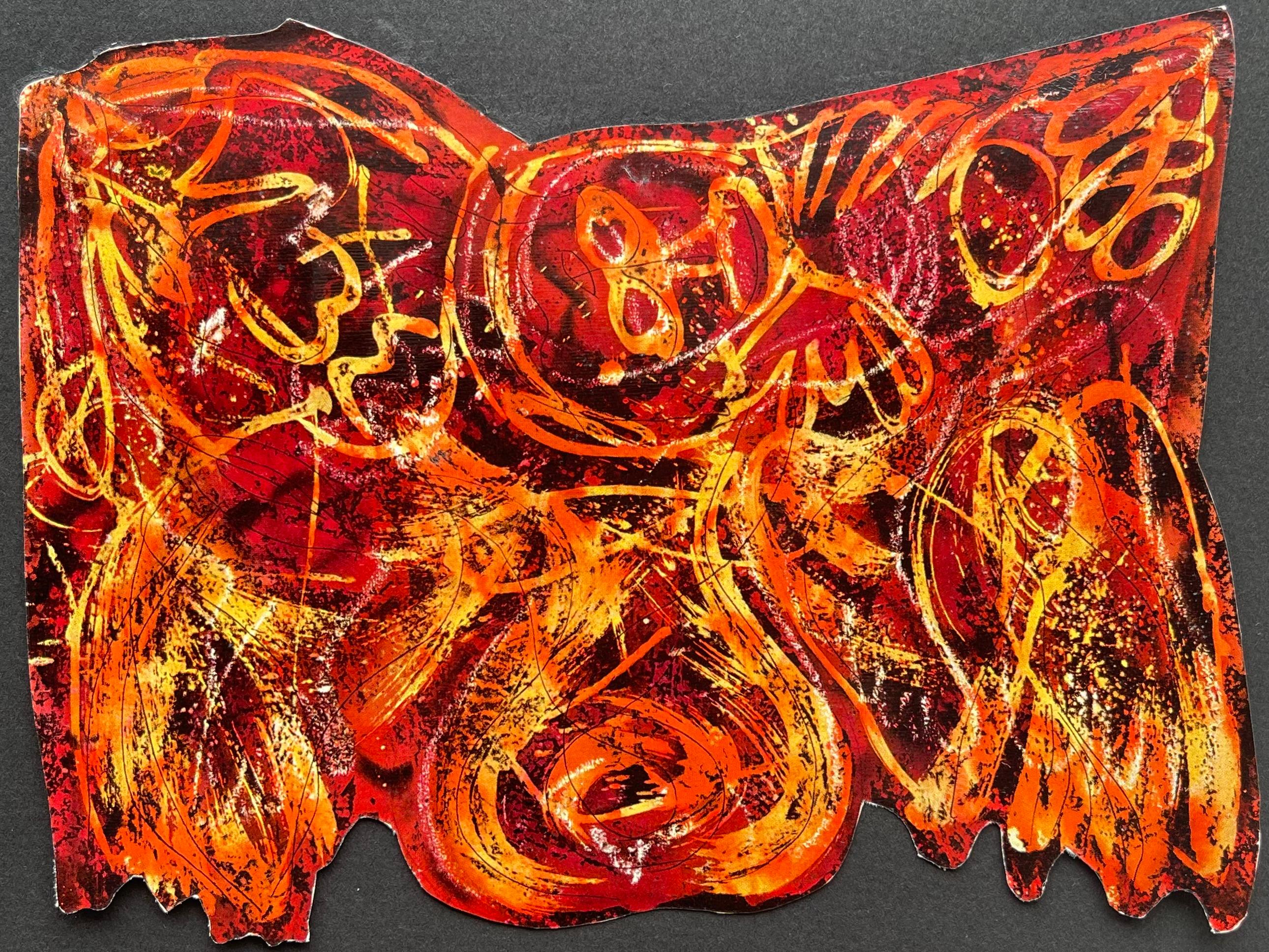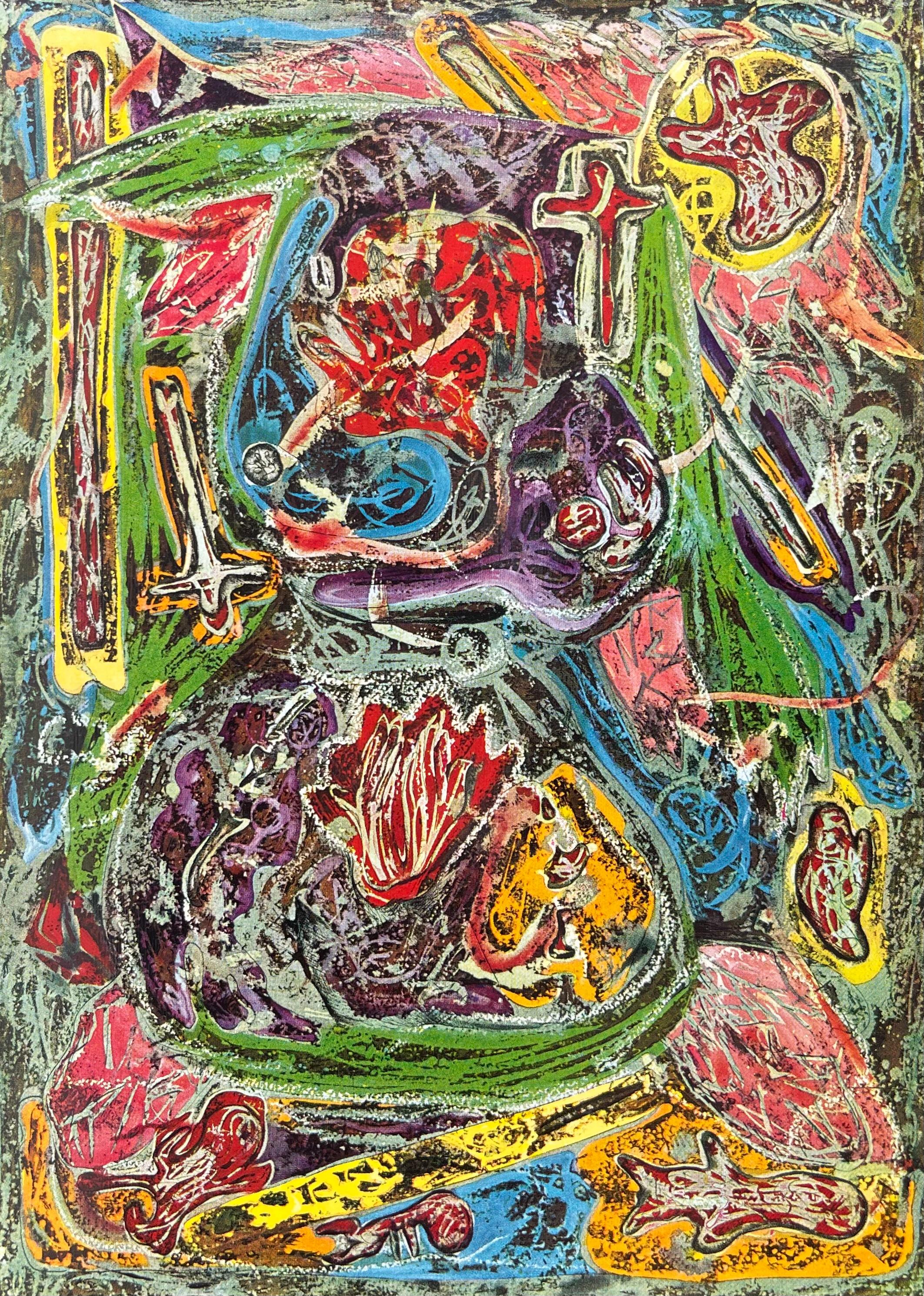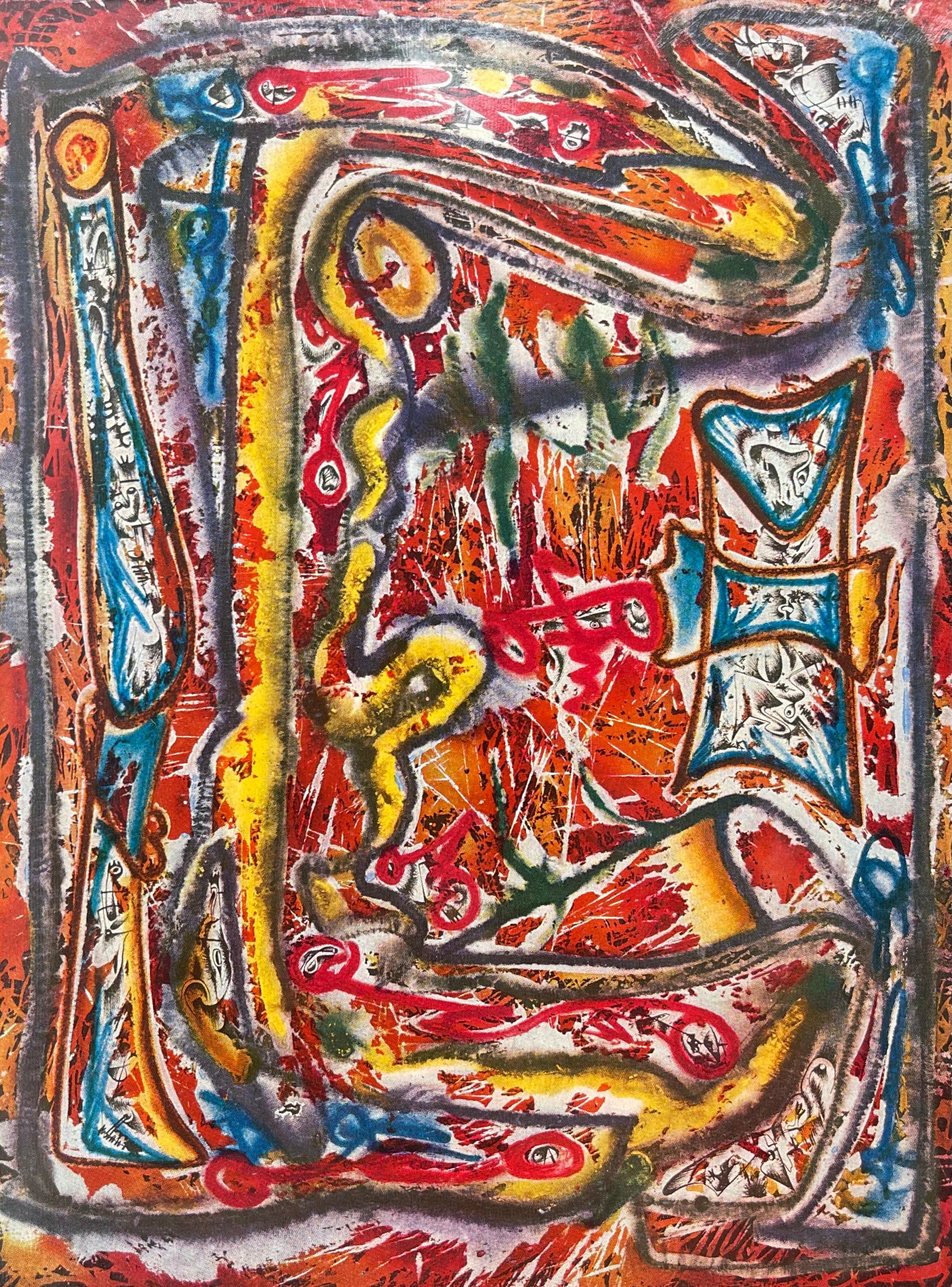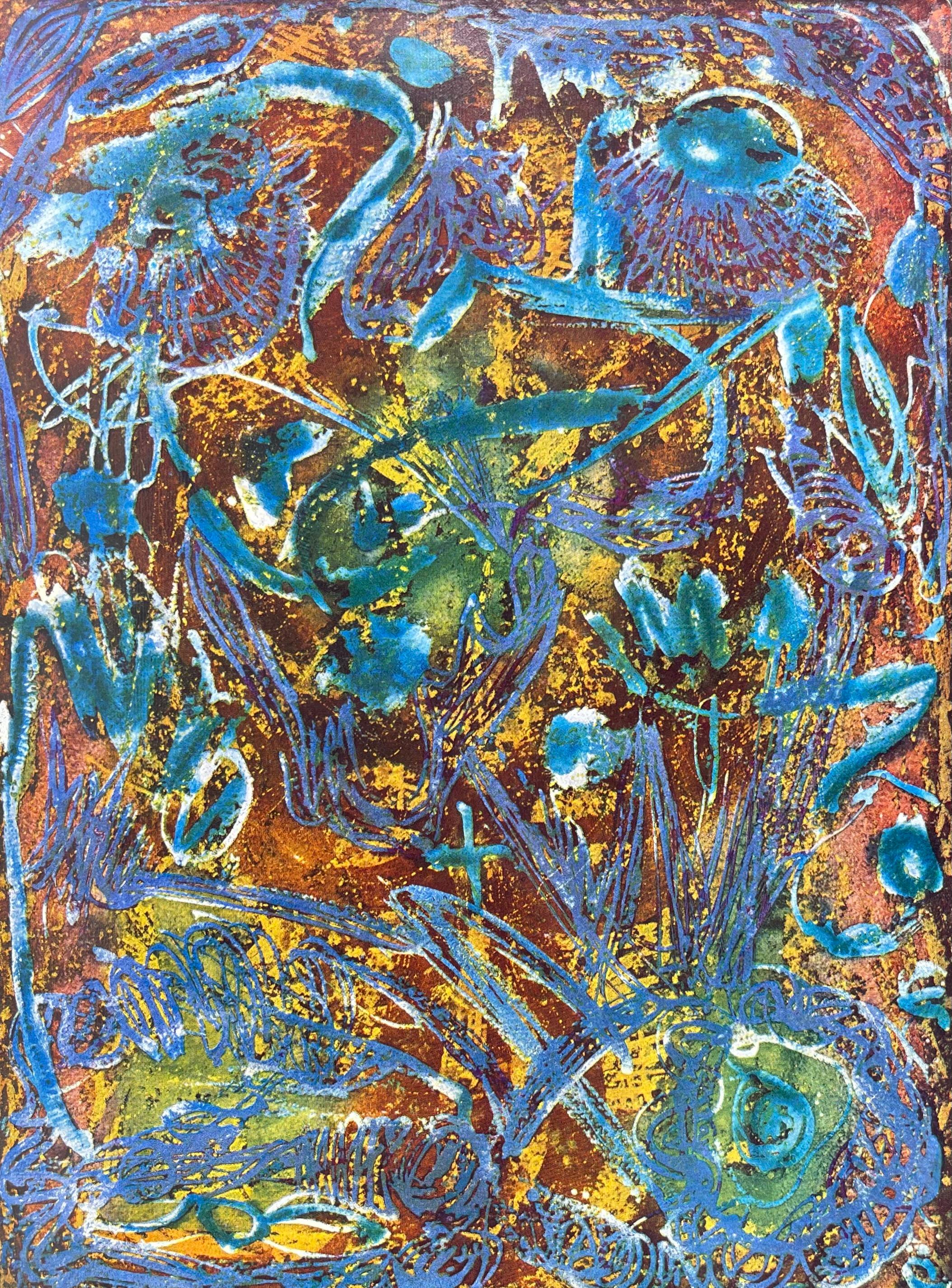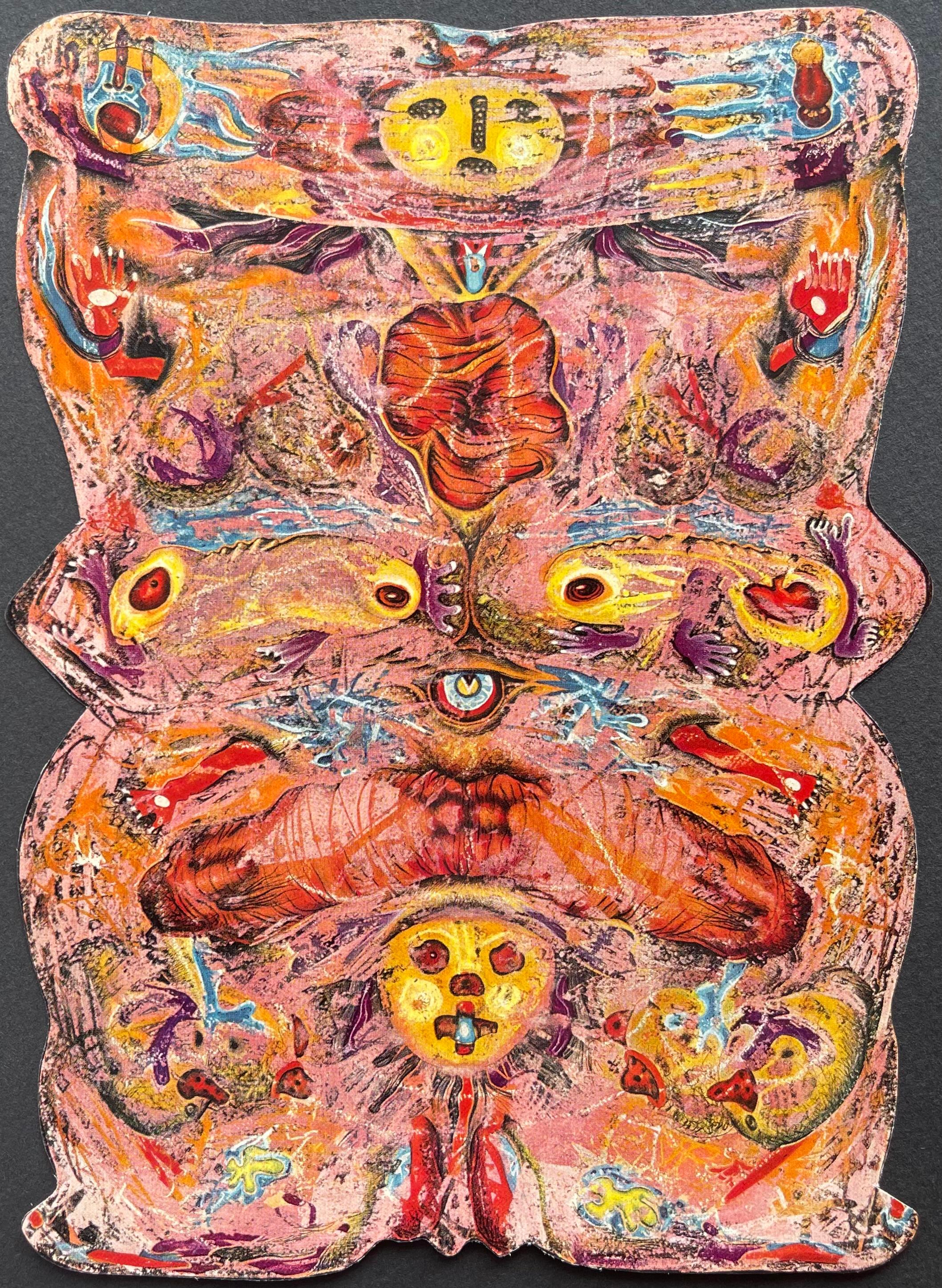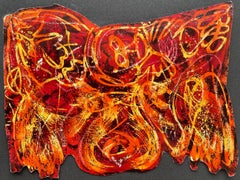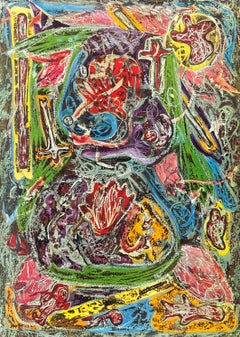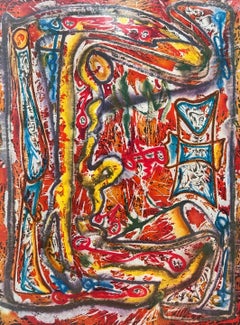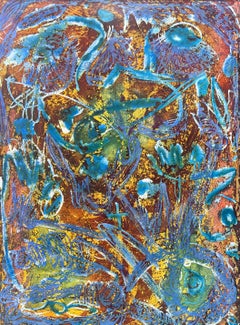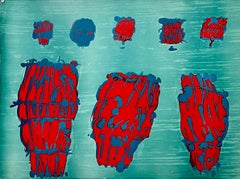Items Similar to Alfonso Ossorio, Number X, from Initiatory Paintings, 1951 (after)
Want more images or videos?
Request additional images or videos from the seller
1 of 8
Alfonso Ossorio, Number X, from Initiatory Paintings, 1951 (after)1951
1951
$716
$89520% Off
£555.61
£694.5120% Off
€627.32
€784.1520% Off
CA$1,024.53
CA$1,280.6620% Off
A$1,117.95
A$1,397.4420% Off
CHF 578.39
CHF 722.9920% Off
MX$13,374.02
MX$16,717.5320% Off
NOK 7,306.46
NOK 9,133.0820% Off
SEK 6,860.65
SEK 8,575.8220% Off
DKK 4,684.97
DKK 5,856.2120% Off
About the Item
This exquisite collotype after Alfonso Ossorio (1916–1990), titled Peinture initiatique X (Initiatory Painting X), from the album Peintures initiatiques d'Alfonso Ossorio (Initiatory Paintings of Alfonso Ossorio), originates from the 1951 edition published and printed by La Pierre Volante, Paris. This refined work reflects Ossorio’s synthesis of Surrealism and spiritual abstraction, uniting organic form and sacred geometry in a symbolic visual language that bridges mysticism and modernism. Through delicate line and chromatic restraint, Ossorio transforms introspective vision into sacred rhythm, echoing the metaphysical energy that defines his oeuvre.
Executed as a collotype on gloss velin Johannot paper, archivally hinged on velin paper, as issued, this work measures 10.83 x 8.86 inches. Unsigned and unnumbered as issued. The edition demonstrates the masterful production of La Pierre Volante and the enduring craftsmanship associated with postwar Parisian printmaking.
Artwork Details:
Artist: After Alfonso Ossorio (1916–1990)
Title: Peinture initiatique X (Initiatory Painting X), from the album Peintures initiatiques d'Alfonso Ossorio (Initiatory Paintings of Alfonso Ossorio)
Medium: Collotype on gloss velin Johannot paper, archivally hinged on velin paper, as issued
Dimensions: 10.83 x 8.86 inches (27.51 x 22.51 cm)
Inscription: Unsigned and unnumbered as issued
Date: 1951
Publisher: La Pierre Volante, Paris
Printer: La Pierre Volante, Paris
Condition: Well preserved, consistent with age and medium
Provenance: From the album Peintures initiatiques d'Alfonso Ossorio (Initiatory Paintings of Alfonso Ossorio), published and printed by La Pierre Volante, Paris, 1951
Notes:
Excerpted from the album, It was taken from this album thirty-six examples on velin d’Arches paper accompanied by a color lithograph of A. Ossorio, numbers from I to XXXVI; MCDXL examples on velin Johannot, numbered from I to MCDXL; sixty examples on velin Johannot, out of commerce.
About the Publication:
Peintures initiatiques d'Alfonso Ossorio (Initiatory Paintings of Alfonso Ossorio), published and printed by La Pierre Volante in Paris in 1951, stands among the most refined artist’s albums of the postwar era. This limited and meticulously executed series chronicles Ossorio’s mystical compositions that merge Surrealist invention with spiritual symbolism. Printed in collotype—a process prized for its tonal precision and depth—the album exemplifies the mid-century French devotion to artisanal printing and intellectual artistry. Combining Ossorio’s transcendental vision with La Pierre Volante’s technical mastery, the publication reflects the era’s synthesis of art, philosophy, and craftsmanship, preserving one of the artist’s most significant visual meditations on initiation, faith, and transformation.
About the Artist:
Alfonso Ossorio (1916–1990) was a Filipino-American painter, draftsman, and assemblage artist whose daring fusion of Surrealism, Abstract Expressionism, and spirituality made him one of the most visionary and distinctive figures in 20th-century art. Born in Manila into a devoutly Catholic family of Spanish descent, Ossorio was educated in England and at Harvard University, where his dual interests in art and science shaped his fascination with the human condition and the metaphysical. After moving to New York in the 1940s, he became a central figure in the postwar avant-garde, forming close friendships with Jackson Pollock, Jean Dubuffet, and Clyfford Still, while engaging in dialogue with modern masters such as Pablo Picasso, Alexander Calder, Alberto Giacometti, Salvador Dali, Joan Miro, Wassily Kandinsky, Marcel Duchamp, and Man Ray. His early paintings reflected both the Surrealist interest in dreams and symbolism and the emotional intensity of Abstract Expressionism, blending Catholic iconography with psychological depth and a bold, experimental approach to color and form. In the 1950s, Ossorio developed his most celebrated works—the Congregations—large-scale mixed-media assemblages made from found materials such as shells, bones, glass, driftwood, and resin, arranged into intricate, almost sacred compositions that combined the chaos of nature with the order of divine design. Created at his East Hampton estate, “The Creeks,” these works represented his belief that art was a living expression of spiritual energy and became precursors to later developments in assemblage, installation, and conceptual art. Ossorio’s unique synthesis of mysticism and modernism bridged the spiritual explorations of Surrealism with the expressive freedom of Abstract Expressionism, influencing generations of artists including Robert Rauschenberg, Louise Nevelson, and Joseph Cornell. A passionate collector and patron, Ossorio also introduced American audiences to Jean Dubuffet’s Art Brut while maintaining one of the most important private collections of contemporary art in mid-century America. His works, held in major institutions such as the Museum of Modern Art, the Whitney Museum of American Art, the Guggenheim Museum, and the Centre Pompidou, are celebrated for their radiance, complexity, and spiritual depth. Like his peers Picasso, Calder, Giacometti, Dali, Miro, Kandinsky, Duchamp, and Man Ray, Ossorio transcended stylistic boundaries to create a visual language of profound emotion and cosmic unity. The highest auction record for Alfonso Ossorio was achieved with Composition, which sold for 275,000 USD at Christie’s, New York, on May 17, 2018, confirming his enduring legacy as one of the most innovative and spiritually profound artists of the 20th century.
Alfonso Ossorio Peinture initiatique X Initiatory Painting X Peintures initiatiques d'Alfonso Ossorio Initiatory Paintings of Alfonso Ossorio La Pierre Volante Paris 1951 collotype Surrealism Abstract Expressionism.
- Creation Year:1951
- Dimensions:Height: 10.83 in (27.51 cm)Width: 8.86 in (22.51 cm)
- Medium:
- Movement & Style:
- After:Alfonso Ossorio (1916, Filipino, American)
- Period:
- Condition:
- Gallery Location:Southampton, NY
- Reference Number:1stDibs: LU1465216863432
About the Seller
4.9
Platinum Seller
Premium sellers with a 4.7+ rating and 24-hour response times
Established in 1978
1stDibs seller since 2021
1,219 sales on 1stDibs
Typical response time: <1 hour
- ShippingRetrieving quote...Shipping from: Southampton, NY
- Return Policy
More From This Seller
View AllAlfonso Ossorio, Number VIII, from Initiatory Paintings, 1951 (after)
By Alfonso Ossorio
Located in Southampton, NY
This exquisite collotype after Alfonso Ossorio (1916–1990), titled Peinture initiatique VIII (Initiatory Painting VIII), from the album Peintures initiatiques d'Alfonso Ossorio (Init...
Category
1950s Abstract Expressionist Abstract Prints
Materials
Lithograph
$716 Sale Price
20% Off
Free Shipping
Alfonso Ossorio, Number II, from Initiatory Paintings, 1951 (after)
By Alfonso Ossorio
Located in Southampton, NY
This exquisite collotype after Alfonso Ossorio (1916–1990), titled Peinture initiatique II (Initiatory Painting II), from the album Peintures initiatiques d'Alfonso Ossorio (Initiato...
Category
1950s Abstract Expressionist Abstract Prints
Materials
Lithograph
$716 Sale Price
20% Off
Free Shipping
Alfonso Ossorio, Number IV, from Initiatory Paintings, 1951 (after)
By Alfonso Ossorio
Located in Southampton, NY
This exquisite collotype after Alfonso Ossorio (1916–1990), titled Peinture initiatique IV (Initiatory Painting IV), from the album Peintures initiatiques d'Alfonso Ossorio (Initiato...
Category
1950s Abstract Expressionist Abstract Prints
Materials
Lithograph
$716 Sale Price
20% Off
Free Shipping
Alfonso Ossorio, Number V, from Initiatory Paintings, 1951 (after)
By Alfonso Ossorio
Located in Southampton, NY
This exquisite collotype after Alfonso Ossorio (1916–1990), titled Peinture initiatique V (Initiatory Painting V), from the album Peintures initiatiques d'Alfonso Ossorio (Initiatory...
Category
1950s Abstract Expressionist Abstract Prints
Materials
Lithograph
$716 Sale Price
20% Off
Free Shipping
Alfonso Ossorio, Number IX, from Initiatory Paintings, 1951 (after)
By Alfonso Ossorio
Located in Southampton, NY
This exquisite collotype after Alfonso Ossorio (1916–1990), titled Peinture initiatique IX (Initiatory Painting IX), from the album Peintures initiatiques d'Alfonso Ossorio (Initiato...
Category
1950s Abstract Expressionist Abstract Prints
Materials
Lithograph
$716 Sale Price
20% Off
Free Shipping
Andre Lanskoy, Poetic Rupture, from Painters of Today, 1960 (after)
By André Lanskoy
Located in Southampton, NY
This exquisite heliogravure after Andre Lanskoy (1902–1976), titled Rupture poetique (Poetic Rupture), from the folio Andre Lanskoy, Peintres d'aujourd'hui (Andre Lanskoy, Painters o...
Category
1960s Modern Abstract Prints
Materials
Lithograph
$716 Sale Price
20% Off
Free Shipping
You May Also Like
Untitled #1 Very large mixed media
By Terence La Noue
Located in San Francisco, CA
This artwork "Untitled #1" 1992, is a mixed media (Aquatint, screen print and collage) on heavy wove paper by noted American artist Terence David La Noue, b. 1941. It is hand signed,...
Category
Late 20th Century Abstract Abstract Prints
Materials
Mixed Media
Pietro Consagra Italian Mod Abstract Expressionist Forma, Art Brut Lithograph
By Pietro Consagra
Located in Surfside, FL
Pietro Consagra (Italian, 1920-2005).
Hand signed in pencil and numbered limited edition color lithograph on Magnani paper.
Embossed stamp with limited edition numbers in pencil to lower left, and having artist pencil signature to lower right.
(from a limited edition of 80 with 15 artist's proofs)
Published by Stamperia 2RC, Rome Italy and Marlborough Gallery, Rome, Italy.
Abstract Modernist work in colors, produced in the style of the Forma art movement of Postwar Italy, of which the artist was a prominent member.
Pietro Consagra (1920 – 2005) was an Italian Post war artist working in painting, printmaking and sculpture. In 1947 he was among the founding members of the Forma 1 group of artists, proponents of structured abstraction. (similar to the Art Informel and Art Brut in France and the Brutalist artists)
Consagra was born on 6 October 1920 in Mazara del Vallo, in the province of Trapani in south-western Sicily, to Luigi Consagra and Maria Lentini. From 1931 he enrolled in a trade school for sailors, studying first to become a mechanic, and later to become a captain. In 1938 he moved to Palermo, where he enrolled in the liceo artistico; despite an attack of tuberculosis, he graduated in 1941, and in the same year signed up at the Accademia di Belle Arti, where he studied sculpture under Archimede Campini. After the Invasion of Sicily and the Allied occupation of Palermo in 1943, Consagra found work as a caricaturist for the American Red Cross club of the city; he also joined the Italian Communist Party. Early in 1944, armed with a letter of introduction from an American officer, he travelled to Rome. There he came into contact with the Sicilian artist Concetto Maugeri, and through him with Renato Guttuso, who was also Sicilian and who introduced him to the intellectual life of the city and to other postwar artists such as Leoncillo Leonardi, Mario Mafai and Giulio Turcato. Consagra signed up at the Accademia di Belle Arti di Roma in September 1944 and studied sculpture there under Michele Guerrisi, but left before completing his diploma.
In 1947, with Carla Accardi, Ugo Attardi, Piero Dorazio, Mino Guerrini, Achille Perilli, Antonio Sanfilippo and Giulio Turcato, Consagra started the artist's group Forma 1, which advocated both Marxism and structured abstraction.
Steadily Consagra's work began to find an audience. Working primarily in metal, and later in marble and wood, his thin, roughly carved reliefs, began to be collected by Peggy Guggenheim and other important patrons of the arts. He showed at the Venice Biennale eleven times between 1950 and 1993, and in 1960 won the sculpture prize at the exhibition. During the 1960s he was associated with the Continuità group, an offshoot of Forma I, and in 1967 taught at the School of Arts in Minneapolis. Large commissions allowed him to begin working on a more monumental scale, and works of his were installed in the courtyard of the Foreign Ministry in Rome and in the European Parliament, Strasbourg. His work is found in the collections of The Tate Gallery, London, in Museo Cantonale d'Arte of Lugano and the Museum of Modern Art, Paris, and the National Gallery of Art in Washington, D.C..
Consagra returned to Sicily where he sculpted a number of significant works during the 1980s. With Senator Ludovico Corrao, he helped created an open-air museum in the new town of Gibellina, after the older town had been destroyed in the earthquake of 1968. Consagra designed the gates to the town's entrance, the building named "Meeting" and the gates to the cemetery, where he was later buried.
In 1952 Consagra published La necessità della scultura ("the need for sculpture"), a response to the essay La scultura lingua morta ("sculpture, a dead language"), published in 1945 by Arturo Martini. Other works include L'agguato c'è ("the snare exists", 1960), and La città frontale ("the frontal city", 1969). His autobiography, Vita Mia, was published by Feltrinelli in 1980. In 1989 a substantial retrospective exhibition of work by Consagra was shown at the Galleria Nazionale d'Arte Moderna in Rome; in 1993 a permanent exhibition of his work was installed there. In 1991 his work was shown in the Hermitage Museum in St. Petersburg. In 2002 the Galerie der Stadt Stuttgart opened a permanent exhibition of his work. He was one of ten artists invited by Giovanni Carandente, along with David Smith, Alexander Calder, Arnaldo Pomodoro, Lynn Chadwick, and Beverly Pepper, to fabricate works in Italsider factories in Italy for an outdoor exhibition, "Sculture nella città", held in Spoleto during the summer of 1962. He was included in the The 1962 International Prize for Sculpture the jury included Argan, Romero Brest and James Johnson Sweeney the former director of the Solomon R. Guggenheim Museum in New York. The participants included Louise Nevelson and John Chamberlain for the United States; Lygia Clark for Brazil; Pietro Consagra, Lucio Fontana, Nino Franchina, and Gió Pomodoro for Italy; Pablo Serrano for Spain; and Eduardo Paolozzi, William Turnbull, and Kenneth Armitage for England. Gyula Kosice, Noemí Gerstein, Julio Gero, Naum Knop...
Category
1960s Abstract Expressionist Abstract Prints
Materials
Lithograph
Untitled
By Gina Pellón
Located in Miami, FL
Gina Pellón (1926-2014)
"Untitled"
Lithograph
30 x 20 in
Signed by the artist at the bottom right corner
Category
20th Century Abstract Expressionist Abstract Prints
Materials
Lithograph
$1,000
Untitled VII, Abstract Expressionist Etching by Alfonso Ossorio
By Alfonso Ossorio
Located in Long Island City, NY
Artist: Alfonso Ossorio (Filipino, 1916-1990)
Title: Untitled VII
Year: 1984/1990
Medium: Etching, signed in pencil
Edition: P.P.
Image Size: 23.5 x 17.75 inches
Paper Size: 30.75 x ...
Category
1980s Abstract Expressionist Abstract Prints
Materials
Etching
LA TAILLE DOUCE
By Pierre Alechinsky
Located in Aventura, FL
Lithograph in colors on paper. Hand signed and numbered in pencil. From the edition of 100.
Artwork is in excellent condition. Certificate of Authenticity included. All reasonabl...
Category
1960s Abstract Expressionist Animal Prints
Materials
Paper, Lithograph
$1,912 Sale Price
25% Off
At Galerie 33, 1986
Located in Brooklyn, NY
This striking exhibition poster by Peter Nyborg showcases his mastery of color and form. Printed on heavy stock paper, it boasts vibrant, richly layered hues that radiate energy and ...
Category
1980s Abstract Expressionist Abstract Prints
Materials
Offset
$200 Sale Price
20% Off
